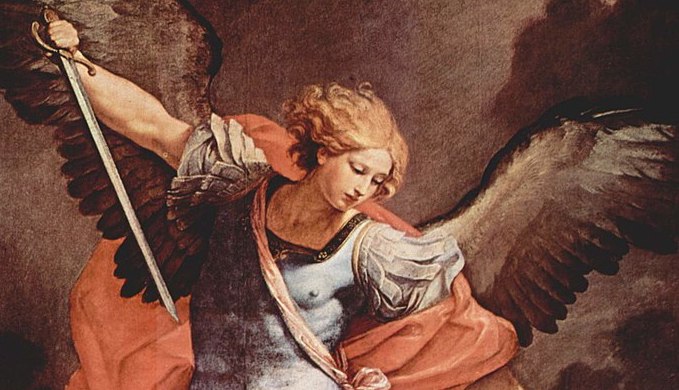As we begin to uncover the legendary “Sword of St. Michael,” we should first take a look at who St. Michael is in the first place. By discovering who (and what) St. Michael is, we will be better able to understand the significance of this prophetic line of monasteries.
[featured-image single_newwindow=”false”]
First of all, the English word “angel” comes from the Latin angelus, meaning “messenger of God.” The Latin stems from the Greek ἄγγελος ángelos, which is a translation of the Hebrew mal’ākh, meaning “messenger,” “delegate,” or “ambassador.” The Catechism of the Catholic Church puts it this way:
329 St. Augustine says: “‘Angel’ is the name of their office, not of their nature. If you seek the name of their nature, it is ‘spirit’; if you seek the name of their office, it is ‘angel’: from what they are, ‘spirit’, from what they do, ‘angel.’ ” With their whole beings the angels are servants and messengers of God. Because they “always behold the face of my Father who is in heaven” they are the “mighty ones who do his word, hearkening to the voice of his word”.
The word “angel” then simply describes what they do and not what they are. Angels are above all messengers and as we will see when we open up sacred scripture, they are messengers of God’s divine plan.
In terms of their nature, as St. Augustine noted in the above quote, angels are “spirits.” Succinctly put in the “Baltimore Catechism:”
37. What are angels? Angels are created spirits, without bodies, having understanding and free will.
John Paul II commented on this doctrine in a General Audience on July 30, 1986:
According to Sacred Scripture the angels, inasmuch as they are purely spiritual creatures, are presented for our reflection as a special realization of the “image of God,” the most perfect Spirit, as Jesus himself reminds the Samaritan woman in the words: “God is spirit” (Jn 4:24). From this point of view the angels are creatures closest to the divine exemplar.
Just as God is by nature a pure spirit, the angels are pure spirits without a body. In this way they image God in a way that we humans do not.
Angels then are neither male nor female as they lack any anatomy at all. They can, however, assume the appearance of a human, but it is more like a “costume” than anything substantial. When they appear to humans they do so for our benefit and appear in a form that we can see with our eyes. Otherwise angels are invisible to our senses.
Because of their lack of bodies, angels do not occupy space like we do and move within our world without taking up space. The closest analogy to how angels move is like “electrons” or in “quantum leaps.” Angels “move instantaneously from one place to another without passing through any space or time in between” (Peter Kreeft, Angels and Demons, 69-70).
With this in mind, St. Michael can be said to be a pure spirit, created by God, sent as a messenger to humanity.
However, he is not simply an angel, but one of the “archangels” according to sacred scripture.
Traditionally, angels are divided into what is called “nine choirs.” It is based on nine names of ranks of angels that is found in the Bible. Saint Paul refers to them in his letters.
Which he wrought in Christ, raising him up from the dead, and setting him on his right hand in the heavenly places. Above all principality, and power, and virtue, and dominion, and every name that is named, not only in this world, but also in that which is to come. (Ephesians 1:20-21)
For in him were all things created in heaven and on earth, visible and invisible, whether thrones, or dominations, or principalities, or powers: all things were created by him and in him. (Colossians 1:16)
The Old Testament adds Cherubim and Seraphim (in multiple places) and we see the “archangels” named in the New Testament (Gabriel, Michael) and in the Old Testament (Raphael and Michael are also referenced there).
Saint Gregory the Great (540 – 604 AD) made a complete list of these “choirs” in a homily:
We know on the authority of Scripture that there are nine orders of angels, viz., Angels, Archangels, Virtues, Powers, Principalities, Dominations, Throne, Cherubim and Seraphim. That there are Angels and Archangels nearly every page of the Bible tell us, and the books of the Prophets talk of Cherubim and Seraphim. St. Paul, too, writing to the Ephesians enumerates four orders when he says: ‘above all Principality, and Power, and Virtue, and Domination’; and again, writing to the Colossians he says: ‘whether Thrones, or Dominations, or Principalities, or Powers’. If we now join these two lists together we have five Orders, and adding Angels and Archangels, Cherubim and Seraphim, we find nine Orders of Angels.” (Hom. 34, In Evang.)
These “orders” or “choirs” of angels refer to their tasks as assigned to them by God. Peter Kreeft gives a great summation of these different roles in his book Angels and Demons. In regards to St. Michael, he is an archangel and Kreeft writes, “The archangels (such as Gabriel) carry God’s important messages to man.” Furthermore, archangels are the second lowest rank of angels and are one of the few choirs who can communicate with humans.
To update our summary statement, St. Michael is a pure spirit, created by God, sent as a messenger of importance to humanity. In other words, if St. Michael has something to say, we should listen.
What is St. Michael’s message? For that, we will have to look at the beginning and end of the Bible.
Read More: Embark on a journey to discover the truth behind the legendary ‘Sword of St. Michael’

